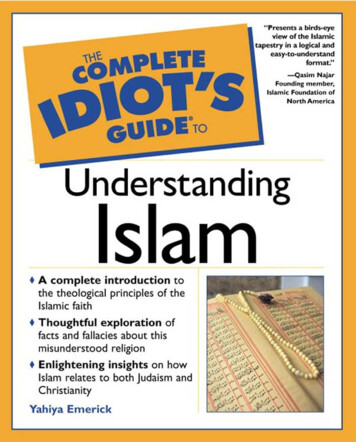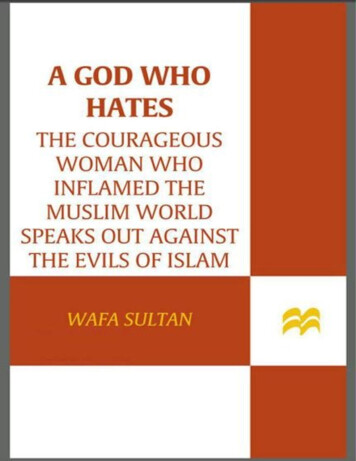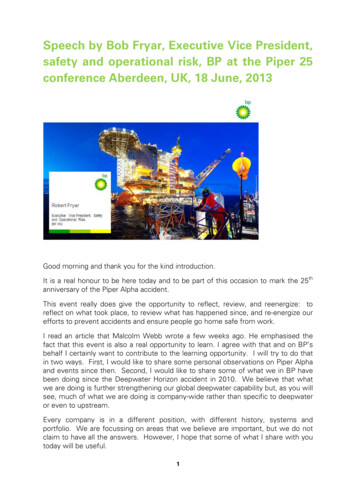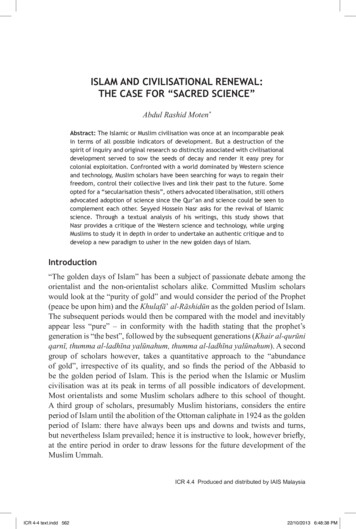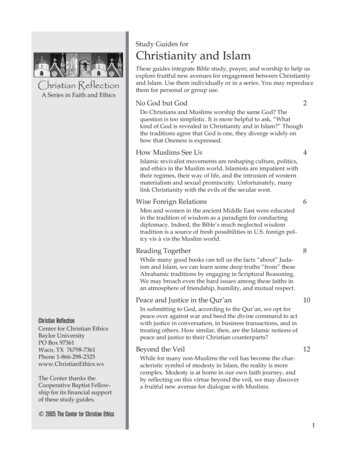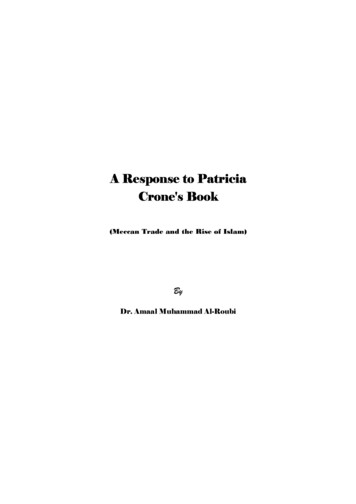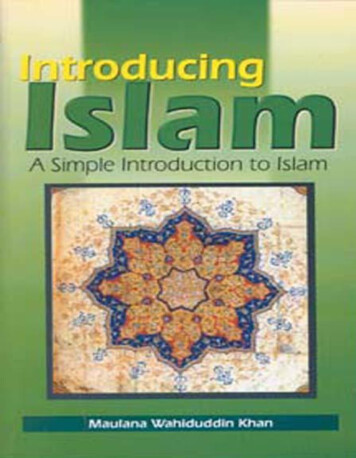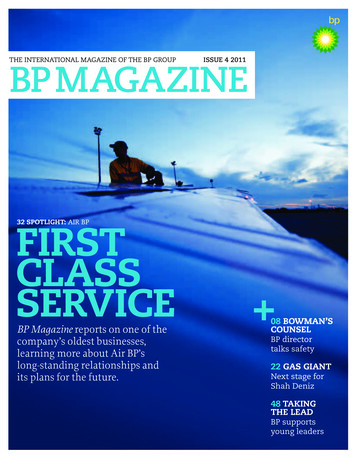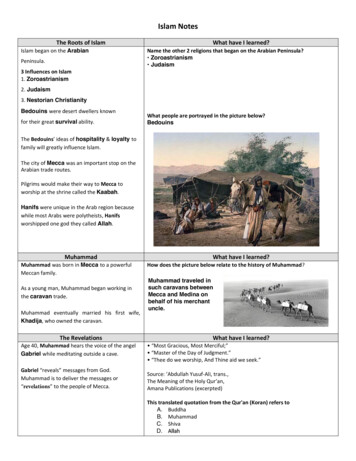
Transcription
Islam NotesThe Roots of IslamIslam began on the ArabianPeninsula.3 Influences on Islam1. ZoroastrianismWhat have I learned?Name the other 2 religions that began on the Arabian Peninsula? Zoroastrianism Judaism2. Judaism3. Nestorian ChristianityBedouins were desert dwellers knownfor their great survival ability.What people are portrayed in the picture below?BedouinsThe Bedouins’ ideas of hospitality & loyalty tofamily will greatly influence Islam.The city of Mecca was an important stop on theArabian trade routes.Pilgrims would make their way to Mecca toworship at the shrine called the Kaabah.Hanifs were unique in the Arab region becausewhile most Arabs were polytheists, Hanifsworshipped one god they called Allah.MuhammadMuhammad was born in Mecca to a powerfulMeccan family.As a young man, Muhammad began working inthe caravan trade.Muhammad eventually married his first wife,Khadija, who owned the caravan.The RevelationsAge 40, Muhammad hears the voice of the angelGabriel while meditating outside a cave.Gabriel “reveals” messages from God.Muhammad is to deliver the messages or“revelations” to the people of Mecca.What have I learned?How does the picture below relate to the history of Muhammad?Muhammad traveled insuch caravans betweenMecca and Medina onbehalf of his merchantuncle.What have I learned? “Most Gracious, Most Merciful;” “Master of the Day of Judgment.” “Thee do we worship, And Thine aid we seek.”Source: ’Abdullah Yusuf-Ali, trans.,The Meaning of the Holy Qur’an,Amana Publications (excerpted)This translated quotation from the Qur'an (Koran) refers toA. BuddhaB. MuhammadC. ShivaD. Allah
Muhammad becomes convinced that he was theprophet of God (Allah).Allah is the one & only god – all other gods mustbe abandoned.Islam “submission to the will of Allah”Muslim “one who submits to the will of Allah”Muhammad was exiled by the people of Meccabecause merchants feared the pilgrimages to thecity would stop.Why do you think Muhammad recited the revelations that he claimed toexperience?A. He could not read or write.B. He did not want his words to appear in written form.C. He believed that Allah wanted him to reveal the revelations only bythe spoken word.D. He believed that others could more accurately record the revelations.Why did the merchants of Mecca resent/fear Muhammad’s message?The merchants of Mecca feared the pilgrimages to the town and theKaabah would cease if Muhammad's message spread.Muhammad & his followers were exiled toMedina.The Hijrah (Hegira)Muhammad escaped the persecution in Mecca bymigrating to the city of Medina in 622. In Yathrib,Muhammad was accepted as a political & religiousleader.What have I learned?What does this map represent?Muhammad's HijirahYathrib was renamed Medina - (city of theprophet.)The significance of the migration(Hegira) is that itresulted in the first community of Muslims inIslam.622 CE marks the first year of the IslamicCalendar.The Arabs trace their ancestors to Abraham and his son Ishmael, who werebelieved to have built a house of worship called the Kaaba at Makkah (Mecca). A sacredstone, called the Black Stone, is the cornerstone of the Kaaba.The Arabs revered the Ka’aba for its association with the house of God.What does the image below represent?In 630 CE, Muhammad led his Bedouin fighterstowards Mecca where leaderssoon surrendered.In Mecca, Muhammad made his way to theKaabah, destroyed its idols & remade it a Muslimshrine by calling for prayer from its rooftop.Spread of IslamReasons for its Quick Spread:1. Exhaustion by the Byzantine and SassanidEmpires2. The ease of Islam for the newly faithful3. Muslim armies spread into lands theyconquered.What have I learned?“Perhaps . . . another kind of explanation can be given for the acceptance of Arab rule by thepopulation of the conquered countries. To most of them it did not much matter whether theywere ruled by Iranians, Greeks or Arabs. Government impinged for the most part on the life ofcities. . . . [C]ity-dwellers might not care much who ruled them, provided they were secure, atpeace and reasonably taxed. The people of the countryside . . . lived under their own chiefs and. . . with their own customs, and it made little difference to them who ruled the cities. For some,the replacement of Greeks and Iranians by Arabs even offered advantages.”According to the passage, why was Arab rule readily accepted by people in thecountryside?A. All governments made people’s lives difficult.B. Arab customs were already familiar to them.C. The Arab government treated people in the countryside better than people living incities.D. Arab govt focused on cities and largely left people in the countryside alone.
Beliefs & Practices1.Only one God - Allah2. Good and Evil exist3. People have Free Will4. There is a Heaven & Hell, andthere will be a Final Judgement Day5. The Quran is the Holy Book ofGodThe 5 Pillars of Islam1. Shahadah - sincerely reciting the Muslimprofession of faith2. Salat - performing ritual prayers in theproper way five times each day.3. Zakat - paying an alms (or charity) tax tobenefit the poor and the needy4. Sawm - fasting during the month ofRamadan.5. Hajj - pilgrimage to Mecca.Mosque Islamic House of Worshipzakat CharityRamadan holy month for fasting. Time whenMuslims believe the Qu'ran was revealedWhat have I learned?1. In the name of Allah, Most Gracious, Most Merciful.2. Praise be to Allah, The Cherisher and Sustainer of the Worlds;3. Most Gracious, Most Merciful;4. Master of the Day of Judgement.5. Thee do we worship, And Thine aid we seek.6. Show us the straight way,7. The way of those on whom Thou hast bestowed Thy Grace, Those whose(portion) Is not wrath, And who go not astray.— ‘Abdullah Y usuf ‘Al l, ed.,The Meaning of The Holy Qur’a n,Amana Publications, 1999Which concept is best reflected in this passage?A. BaptismB. KarmaC. MonotheismD. AnimismWhat have I learned?Which practice is most closely associated with a person of the Islamic faith?A. refraining from eating meat on FridaysB. praying five times a dayC. following the Eightfold PathD. worshipping the god Shiva“Ramazan [Ramadan] . . . is an occasion during which believers are thought to becloser to God. Ramazan is a month-long period of fasting, somewhat like Lent only morestringent. It is a time of atonement. It is the month in which the [Quran] was allegedlyrevealed to [Muhammad]. It is said: ‘When the noble time of Ramazan comes, the doorsof heaven are opened, the doors of hell closed, and the devils tied down.’ In otherwords, people’s souls are opened to God and closed to seytan (devils); they aresustained by God as by food.”—Carol Delaney, The Seed and the Soil: Gender and Cosmology in Turkish VillageSociety, 1991According to the passage, what helps people as they fast during Ramadan?The power of God, which sustains them as food does.Hajj Muslim Pilgrimage. Must be made oncein a lifetimeMuslim Way of LifeForbidden to eat/drink:1. Pork2. AlcoholCommunal prayer held on FridayWhat have I learned?Why do you think Muslims are forbidden to drink alcohol?Imam's are prayer leaders.Muslim Sources of Authority1. Qu'ran2. SunnahOnly Arabic version is true.3. Imams4. ShariaBody of LawWhat have I learned?Why do Muslims believe that only the Arabic version of the Qur’an is true?Because they believe the Arabic version is the only one that has been passeddown unfiltered from Muhammad.
Muslims believe that Jews & Christians are“People of the Book”; that they share a commonancestry---all the way to Abraham.After MuhammadWhat have I learned?A caliph is a “successor or deputy”stThe 1 Caliph was Muhammad’s father-in-law,Abu Bakr.The Four Loyal Caliphs are the 1 4 leaders afterMuhammad; named so for their loyalty toMuhammadst1. Abu Bakr2. Umar3. Uthman4. AliGrowth of Islamic Movement under Abû Bakr640 A.D.Gained control of the Byzantine province of Syria642 A.D.Added Egypt and parts of northern Africa to new Arab Empire650 A.D.Conquered the entire Persian empireBased on the table, which is a logical conclusion about the growth of theIslamic movement?A. The Arab Empire grew as a result of diplomatic negotiations.B. The Red Sea marked the eastern boundary of the Arab Empire.C. The growth of the Islamic movement was small in territorial terms.D. Arab conquests initially focused on neighboring territories.When did the conflict between Sunni and Shi’a Muslims begin?A. When Muhammad diedB. Before Muhammad was bornC. With the Abbasid DynastyD. When Muslims built MeccaIn 656, the caliph, Uthman was murdered.Ali, son-in-law of Muhammad was named 4Caliph but is challenged by Uthman’s son,Mu'awiyah.thUthman is murdered by a disillusionedfollower & Mu’awiyah begins Islam’s first dynastyMuhammad died without naming a successor. How might things have beendifferent if he had?Islam may have remained intact, instead of breaking into Sunni and Shi'asects that have been contentious ever since.– the Umayyad dynastyIslamic Dynasties1. UmayyadWhat have I learned?Ac2. AbbasidUmayyadYears 661-750Capital DamascusContributions to Govt. set hereditary systemof successionAbbasidYears 750-1258Capital BaghdadContributions to Govt. opened diplomacywith European statesAccording to the map, which dynasty carried Islam into Spain & Persia?
Sunni-Shi’a Split – Islamic SectsSunniSupport UmayyadAdherents? Majority of MuslimsImam prayer leader onlyCaliph any righteous Muslim may be oneWhat have I learned?How do the beliefs of Shiite and Sunni Muslims differ?a.Sunnis seek God through mysticism and elaborate rituals.b.Shiites believe that a caliph has no prophetic functions.c.Shiites are followers of Muhammad’s son-in-law, Ali.d.Sunnis are followers of Muhammad’s son-in-law, Ali.The accepted the Umayyads as rulers.A.Shi’aC.SunnisB.sheikhs D.Ka’abasShi’a (Shi’ite)Support Ali & his familyAdherents? Minority of MuslimsImam spiritual leaderCaliph Must be descended of Ali andFatimaSufis are they mystical sect of Islam.End of the Spread of Islam1.Frankish king, Charles Martel stopsMuslim advance into Europe.Muslim mystics who sought communion with God through meditation andfasting were calleda.Sunnis. c.Shiites.b.Sufis. d.Shahs.What have I learned?Which of the following was a result of the Battle of Tours?A. Islamic forces gained control of the entire Arabian PeninsulaB. Muslim expansion into Europe was haltedC. The Byzantine Empire ceased to existD. Spain fell under the control of Islamic forces2.Grandson of Genghis Khan burnscity & kills last Abbasid caliph.The Muslim Golden Age - Urban CentersEducation in Muslim cities increased with thecreation of universities.Muslim scholars played an important role intranslating & thereby preserving the works ofGreece & Rome.What have I learned?Which statement about the Golden Age of Islam is a fact rather than anopinion?A. Islamic art was more abstract than Greek artB. Muslims were the best early mathematiciansC. Islamic society preserved Greek and Roman cultureD. Muslim artists had more talent than European artistsMuslim scholars also improved the discoveries ofIndia &Persia.The most important Muslim Urban centers were:1. Baghdad2. Cordoba3. Damascus4. Cairo5. Timbuktu (Mali)How do you think these cities impacted the spread of Islam?As non-Muslims are drawn to these reat centers of learning, they areexposed to Islam and its teachings, which they often take back to theirown lands.
Role of Women in IslamRights of women were/are determined byinterpreters of the Koran/Quran.Women were responsible for the children &home but could also get an education.What have I learned?True or False: Throughout history, Muslim women have had few rights.FalseWomen are often covered by garments calledBurkhas.Muslim UniversitiesThe first Muslim University, called the House ofWisdom was opened by Caliph al-Ma'mum inthe 800’s CE.The House of Wisdom included a :1. library2. academy3. translation centerMuslim scholars interpreted/translated worksfrom :What have I learned?According to the image below, what types of activities occurred in the Houseof Wisdom?Scholarship and debate1. Greece2. Rome3. India4. PersiaMuslim Medical AdvancesThe physician al-Razi compiled Medicalknowledge from Greece, Syria, India & Arabia intoan encyclopedia called the Comprehensive BookIn his study of Smallpox, Al Razi wrote that cleanair could aid in recovery as well as good nutrition& exercise. Al Razi’s findings were written in theTreatise on Smallpox & Measles.What have I learned?Achievements of Islamperfected the astrolabedeveloped medicine as a field of scientific studysought a scientific basis for studying historyIslamic art and architecturein literature, the Rubaiyat and The Arabian NightsAccording to the chart, what field did Muslims develop as a field of scientificstudy?MedicineMuslim Mathematical AchievementsMost of the achievements made in mathematicswere a result of their study of astronomy.The mathematician al-Khwarizmi created atechnique called Al-Jabr known today asAlgebra.In addition, the mathematical principle oftrigonometry developed during the MuslimGolden Age.What have I learned?One similarity between the Gupta Empire and the Arab dynasties of theIslamic Golden Age is that theyA. made advances in mathematics and literatureB. gained wealth by obtaining gold from the AmericasC. stressed the importance of dharma and karmaD. controlled territories around the Mediterranean seacoast
Muslims adopted the Indian numeral system.With its spread, it became known as the ArabicNumeral System.Why were Arabs given credit for the numerical system created by theIndians?Because they were responsible for its widespread adoptionMuslim Scientific AchievementsMuslims were among the first to use observationin science as well as try to replicate what theysaw by conducting experiments in a lab setting.The scientist Ibn al-Haytham produced the firstbook on Optics leading to the development oflenses for telescopes & microscopes.What have I learned?What does this imagerepresent?Muslims scholarsconducting research intoastronomical mattersThe 5 Pillars of Islam led to many advances inAstronomy. Advances were made in the scienceof cartography or map-making.To navigate the seas, the scientific instrumentknown as the astrolabe was invented.Muslim LiteratureThe rich tradition of Muslim storytelling datesback to the Bedouin tribes who would tell storiesin their camps at night.What have I learned?The story of the character below is found in what collection of stories?Aladdin - The Thousand and One NightsThe Quran is considered to be the most standardfor all Islamic literature.The most famous Muslim stories are found in TheThousand and One Nights; a mixture of fairytales, parables, & legends.The collection of poems called the The Rubaiyatof Omar Khayyam was written by OmarKhayyam who was a Mathematician &Astronomer as well as a poet.Muslim ArchitectureMuslim art & literature is enhanced by the art ofbeautiful handwriting called calligraphy.Calligraphy as well as mosaics (art using coloredtiles, etc.) would often decorate the mosques.Much of Islamic architecture is a blending ofByzantine architecture with Islamic ideas.Omar Khayyám is most famous forA. perfecting the sailboat, which made it possible for Europeans to sail tothe Americas.B. writing a medical encyclopedia that became a textbook for medievalEuropean university students.C. his literary works, especially the Rubaiyat.D. developing chess, which is still played around the world today.What have I learned?The passage below is written using calligraphy.
Muslim mosques almost always include prayertowers called minarets.Name the structures below.Taj MahalDome of the RockExamples of Islamic Architecture:The Taj Mahal located in India was built by ShahJahan as a tomb for his wife.The Dome of the Rock in Jerusalem is a Mosquebuilt on a site which is considered sacred to bothMuslims and Jews.By 750, the Muslim empire included all of Southwest Asia, Asia to the borders of India and China, most ofSpain, and all of North Africa. The Muslim government was a theocracy—that is, the caliphs were religious as well aspolitical leaders. Laws were based on the Muslim holy book, the Quran. Muslim leaders adapted laws to localpractices.What type of government was the Muslim empire?A. one headed by a monarchB. one run by a collection of educatedexpertsC. one run by religious leadersD. one run by an elite few“They [the Arabs] were aided by the weakness of the two contemporary empires, the Sassanian (Persian) and the Byzantine, which had largelyexhausted themselves by their wars on one another . . . . Nor were these Arabs simply zealots fired by the ideal of a Holy War. They were by longtradition tough fighters, accustomed to raiding out of hunger and want; many or perhaps even most of them were not ardent followers of Muhammad. Yetthere can be little question that what got the Arabs started, and kept them going, was mainly the personality and the teaching of the prophet.”—Herbert J. Muller, The Loom of History, 1958According to the passage, the weakness of the aided the Arabs.A. Persian EmpireC. Byzantine EmpireB. Roman EmpireD. Both A and CAccording to the passage, the majority of Muslims were NOT .A. tough fightersC. ardent followers of MuhammadB. city dwellersD. peasants who lived on the landBaghdad, 700-900 CEReview the map. What does the placement of the mosque andthe palace imply?A. The residents of Baghdad were permitted to live next tothe mosque.B. That only the ruler had the right to worship at themosque.C. That there is a close relationship between governmentand religion.D. That few people could worship at the mosque becauseit was behind walls.
This translated quotation from the Qur'an (Koran) refers to . A. Buddha B. Muhammad C. Shiva D. Allah Muhammad traveled in such caravans between Mecca and Medina on behalf of his merchant uncle. Muhammad. becomes convinced that he was the prophet of God (Allah).
